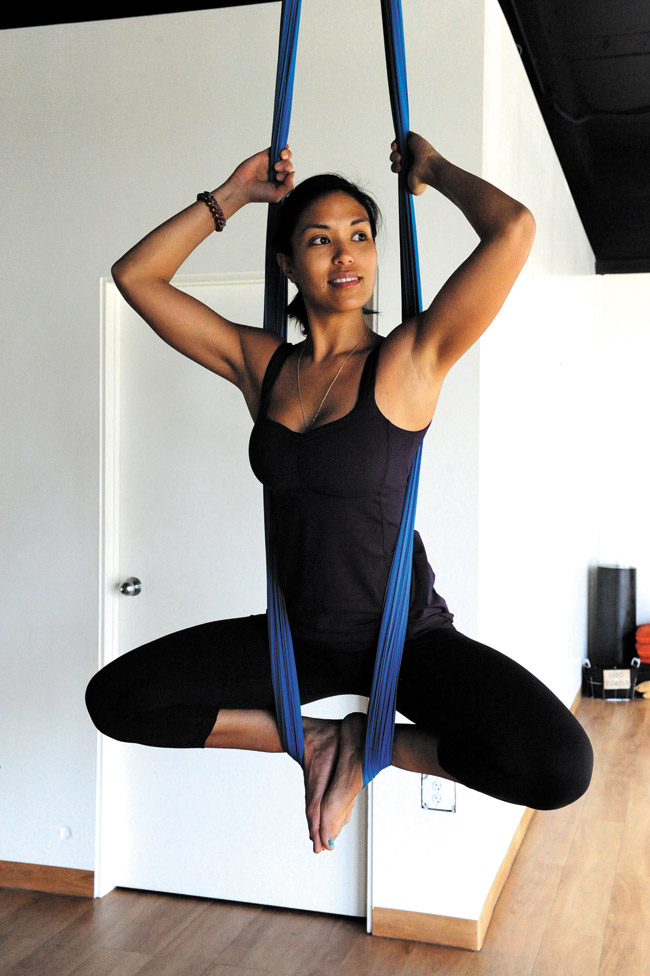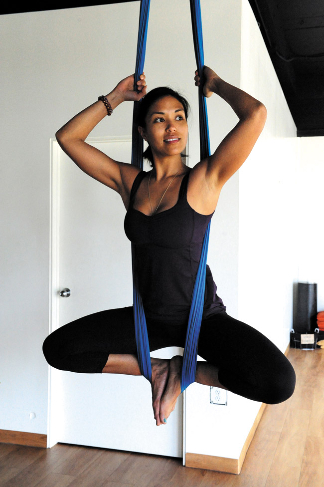Aerial Yoga
There’s a new brand of yoga in the air … literally. Call it aerial yoga, upside down yoga or antigravity yoga, it involves hanging from a silken hammock made of ultra-thin, durable parachute material. The hammock offers support to incorporate all of the asanas (postures) and stretches that are normally done on a yoga mat, only these are done a few feet above ground.
The genre’s popularity has catapulted into the public eye, what with unusual forms of exercise like silk rope dancing gaining ground, and with the current trend toward multidisciplinary ways of staying fit and limber. At the recent Wanderlust yoga festival on Oahu’s North Shore, aerial yoga classes were the first to book up, and R&B singer Pink’s much-lauded performance at the Grammys this year (see it on YouTube) made stunning use of aerial yoga form and technique.
A longtime yoga devotee myself, I recently visited Jordan Shamir’s The Hang Out studio (thehangoutagy.com) devoted solely to the trademarked AntiGravity discipline. The concept is that inverted and suspended yoga helps increase muscular flexibility, core strength, joint mobility and gentle decompression of the spine.
“Inversions also release ‘happy hormones’ like serotonin, endorphins and dopamine,” notes Shamir, who opened the studio last year after seeing a program about the newly popular yoga style on Good Morning America. “This workout is for anyone pursuing better health,” he adds. “It brings a childlike sense of fun and enjoyment to the day.”
How often do adults let loose and swing or hang upside down? In my class, Shamir guided the group into our individual hammocks, which can each hold up to 1,000 pounds. The lights dimmed and cocooned in our sea-blue silks, the space looked beautifully surreal, as though it housed sacks of floating alien embryos. Emerging from our gossamer wraps, we were directed into a variety of forward bends, backbends and full inversions, using the fabric for support. Our feet and thighs gripped the “rope,” our heads dangling toward the floor.
Like a magic jigsaw, we’d intertwine our arms and legs with our hammock. The final step that involved slowly somersaulting forward or backward would give me some nervous butterflies, but then I’d let go and tumble in midair only to land safely, positioned with the rest of the group in some fantastic, hovering tableau.
I’ve never considered myself acrobatic or expert at stretching, but the ease of hanging allowed me to do things I’d normally be struggling with on the traditional mat. The hammock, together with some bodily creativity, make for endless possibilities of yogic movements and asana progressions.
Aerial instructor Wendi Lynch (aerialyogahawaii.com), who claims the distinction of being the first to bring aerial yoga to Hawaii, teaches classes at the Still and Moving Center (stillandmovingcenter.com). Lynch originally happened upon aerial yoga while looking for an indoor activity to combat the gloominess of an Oregon winter. An overall yoga practitioner since 2001 and a teacher trainer in floor and aerial work, Lynch has begun incorporating out-of-the-box modalities like Thai massage into her practice. Speaking of endless creativity, I spotted Lynch at Wanderlust (yoga festival on the North Shore) using outdoor contraptions strung with aerial fabric to teach partner routines.
“People who already have a strong practice, whether it be yoga, Pilates or tennis, feel how aerial yoga complements other movements after just a few classes,” says
Lynch. “People who are struggling with particularly challenging poses in yoga on the floor love when they can break through whatever they were struggling with through aerial yoga.”
Lynch even has had students who try out aerial yoga first and like it so much that they then gravitate to mat yoga. She also points out that aerial yoga can be a full workout unto itself as it balances strength and mobility.
Power couple Lehua and Dorian Wright, owners of Power Yoga Hawaii (poweryogahawaii.com), initially only had a student or two signing up for their aerial classes. But these days they cater to a packed class. Lehua, an athlete and dancer, was turned on to yoga classes after a knee injury. One to push the boundaries, she found herself doing a Google search for “acrobatic yoga.” When she discovered an actual aerial discipline, “I freaked,” she says. She also ended up bruised.
“Because you are hanging on a silk, you have the aid of gravity to get you deeper into postures in your natural alignment,” says Wright. “All of your body weight is hanging from this silk, and that weight gives you a deep-tissue massage almost like shiatsu.”
If you bruise easily, don’t be surprised by some contusions. Those prone to dizziness or afraid of heights, or those not accustomed to going upside down, also might feel some discomfort as their bodies explore the new activity.
Even experienced mat yogis will be entering a fresh frontier, says Wright. Aerial uses postures similar to mat yoga, but they are sequenced differently and they are tweaked to conform to the vertical apparatus. Because it all takes place in the air, she emphasizes the importance of learning from a certified instructor, for safety’s sake.
Once you get the hang of it (wink), says Wright, “You’ll be learning new things about your body with every practice. Not only that, it’s extremely fun and you get a great core!”
I emerged transformed from my own chrysalis of novel physical movement. My body felt lighter stretched and massaged. Moreover, that quiet surge of focused adrenaline needed to contort into some of the positions stayed with me even into the following day. It was as though I’d conquered something, even if it was only my own earthbound inhibitions.







